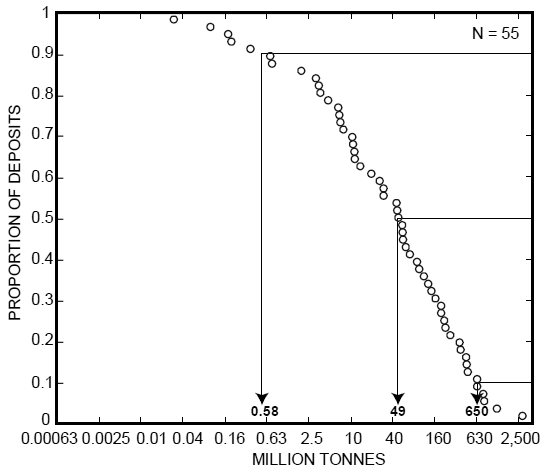Berger,V.I., Singer,D.A. and Orris,G.J.(2009):
Carbonatites
of the World, Explored Deposits of Nb and REE−Database and Grade
and Tonnage Models. Open-File Report 2009-1139, U.S. Department
of the Interior/U.S. Geological Survey, 20p.
『世界のカーボナタイト、NbとREEの調査された鉱床−データベースおよび品位とトン数モデル』
Contents
Introduction 1
Rules Used 2
Data Fields 2
Preliminary analysis: .Grade and Tonnage Models 13
Acknowledgments 16
References 16
Figures
Figure 1. Location of explored Nb. and REE.carbonatite deposits
included in the database and grade and tonnage models 4
Figure 2. Cumulative frequency of ore tonnages of Nb. and REE.carbonatite
deposits 14
Figure 3 Cumulative frequency of Nb2O5 grades of Nb. and REE.carbonatite
deposits 15
Figure 4 Cumulative frequency of RE2O3 grades of Nb. and REE.carbonatite
deposits 15
Figure 4 Cumulative frequency of P2O5 grades of Nb. and REE.carbonatite
deposits 16
Tables
Table 1. Country names and country codes used in this report 3
Table 2. Grouping of deposits by age intervals 5
Table 3. Frequency of rocks associated with carbonatites 6
Table 4. Frequency of country rocks of the carbonatite deposits
7
Table 5. Range of tonnages and alteration areas by configuration
of carbonatite deposits 8
Table 6. Frequency of main ore minerals 10
Table 7. Frequency of minor and rare ore minerals 11
Table 8. Frequency of main gangue minerals 12
Table 9. Frequency of minor and rare gangue minerals 12
Table 10. Grade and tonnage models of carbonatite deposits 14
Introduction
This report is based on published tonnage and grade data on
58 Nb. and rare-earth-element (REE).bearing carbonatite deposits
that are mostly well explored and are partially mined or contain
resources of these elements. The deposits represent only a part
of the known 527 carbonatites around the world (Woolley and Kjarsgaard,
2008), but they are characterized by reliable quantitative data
on ore tonnages and grades of niobium and REE.
Grade and tonnage models are an important component of mineral
resource assessments. Carbonatites present one of the main natural
sources of niobium and rare-earth elements, the economic importance
of which grows consistently. A purpose of this report is to update
earlier publications (Singer, 1986a, 1986b, 1998; Orris and Grauch,
2002). New information about known deposits, as well as data on
new deposits published during the last decade, are incorporated
in the present paper. The compiled database (appendix 1) contains
60 explored Nb. and REE.bearing carbonatite deposits.resources
of 55 of these deposits are taken from publications. In the present
updated grade-tonnage model we have added 24 deposits comparing
with the previous model of Singer (1998). Resources of most deposits
are residuum ores in the upper part of carbonatite bodies.
Mineral-deposit models are important in exploration planning and
quantitative resource assessments for two reasons: (1) grades
and tonnages among deposit types vary significantly, and (2) deposits
of different types are present in distinct geologic settings that
can be identified from geologic maps. Mineral-deposit models combine
the diverse geoscience information on geology, mineral occurrences,
geophysics, and geochemistry used in resource assessments and
mineral exploration. Globally based deposit models allow recognition
of important features and demonstrate how common different features
are. Well-designed deposit models allow geologists to deduce possible
mineral-deposit types in a given geologic environment, and the
grade and tonnage models allow economists to estimate the possible
economic viability of these resources. Thus, mineral-deposit models
play a central role in presenting geoscience information in a
useful form to policy makers. The foundation of mineral-deposit
models is information about known deposits. This publication presents
the latest geologic information and newly developed grade and
tonnage models for Nb. and REE .carbonatite deposits in digital
form. The publication contains computer files with information
on deposits from around the world. It also contains a text file
allowing locations of all deposits to be plotted in geographic
information system (GIS) programs. The data are presented in FileMaker
Pro as well as in .xls and text files to make the information
available to a broadly based audience. The value of this information
and any derived analyses depends critically on the consistent
manner of data gathering. For this reason, we first discuss the
rules used in this compilation. Next, the fields of the database
are explained. Finally, we provide new grade and tonnage models
and analysis of the information in the file.

Figure 1. Location of explored Nb- and REE-carbonatite deposits
included in the database and grade and tonnage models.
Table 2. Grouping of deposits by age intervals [n.d.,
not dated.]
 Table 10. Grade and tonnage models of carbonatite
deposits
Table 10. Grade and tonnage models of carbonatite
deposits
[Mt, million tones. See also figures 2-5.]


Figure 2. Cumulative frequency of ore tonnage of Nb- and REE-carbonatite
deposits. Each circle represents an individual deposit. Intercepts
for the 90th, 50th, and 10th percentiles of the observed distribution
are provided.
USGSによる『Carbonatites
of the World, Explored Deposits of Nb and REE−Database and Grade
and Tonnage Models』から |
ホームへ



